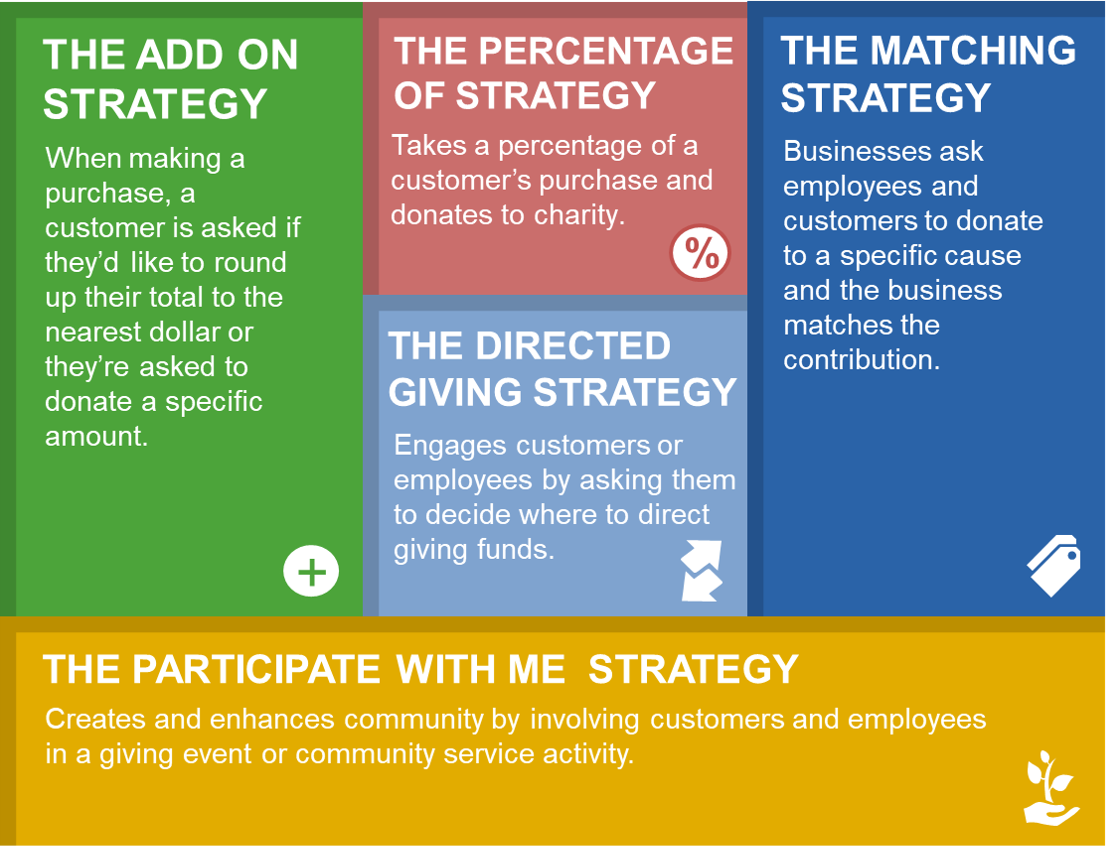Now, more than ever, we’re missing human connection—making touchpoints of impact and finding ways to add value and do good. Doing good and giving back, especially in uncertain times, can help alleviate the feeling of helplessness, provide options for people to feel like they’re making an impact, and plant the seeds for positivity.
Your business may have had a plan for giving before the COVID-19 pandemic or it may have been in the process of creating a giving plan. Perhaps, like many other businesses, when the pandemic hit, yours went into survival mode, temporarily shutting down and waiting for things to improve.
Amidst the pandemic, businesses are looking for ways to reconnect with customers and attract new ones. There’s no sense in waiting to take action and do good. While there are many unknowns, there are also many options for re-engagement—and reasons why the time is now.
Why Re-Engage in Doing Good?
An April 2020 article from McKinsey & Company emphasized the importance of connecting with customers in times of crisis, explaining that by consciously providing empathy and care during this crisis, companies can build a foundation of goodwill and long-lasting emotional connections with the communities they serve. The article includes seven actions for businesses to emotionally connect with customers: Listed as #7: Demonstrate care for the community through company values.
For many small businesses, including INI Sips, the COVID-19 pandemic has had a silver lining by providing the time to rethink not only how to stay afloat, but how to communicate the business’ values. The coffee shop’s owners took the time to access their giving back strategy—and their plan worked. By leading with humanity and cause, INI Sips built trust within their community and showed they care about their customers and community.
In July 2020, the Better Business Bureau (BBB) conducted a COVID-19 Business Impact Report with nearly 1,000 BBB Accredited Businesses. Approximately 25% of the businesses surveyed noted that instilling customer trust will be a challenge moving forward—but also an opportunity. Cash flow, health and safety, and meeting customer expectations are additional challenges. The takeaways noted that companies often reap benefits from refocusing their priorities and ensuring trust is a long-term aspect in building a better business.
Do Good Strategies
Given the current situation, monetary giving may not be an option; however, there are other ways to give back. Below are five strategies for small businesses to re-initiate their do good and give back efforts.
- The Add On Strategy
Chances are you’ve participated in this common strategy at the cash register of your local supermarket or drug store or when you’re paying a bill at a local restaurant. It’s an easy sell and an easy decision for customers to simply round up their anticipated spend.
When making a purchase, a customer is asked if they’d like to round up their total to the nearest dollar or they’re asked to donate a specific amount, such as $1, to their total purchase. Also known as “checkout charity” and “point-of-sale fundraising,” with this strategy, money is raised for a charity that’s aligned with the business’ mission, the business shows it’s a compassionate member of community, and customers feel good about giving back.
The Add On Strategy has been working well for Hot Chicken Takeover, which began an annual Pay It Forward program in December 2016 with all proceeds benefitting Food Rescue US. Customers who add $5 to their order during a specified week in December receive a buy one meal, get one free coupon to redeem in January.
Another way to approach the Add On Strategy is to donate an item instead of a specific dollar amount. For example, during the holidays, Barnes and Noble runs Book Drive where customers can purchase a picture book or a middle grade novel and the company will donate to hundreds of charities across the country.
The monetary- or donation-type Add On Strategy could easily be incorporated at a small or growing business.
2. The Percentage Of Strategy
Understandably, some companies don’t want to ask customers to do anything extra or give more in addition to their purchase. That’s where the Percentage Of Strategy can be effective. Instead of asking customers to add to their purchase or buy something to give, this strategy takes a percentage of the purchase and donates it to charity, which still enables customers to feel they’re supporting an important cause.
On a set day in June, Hartford Baking Company donated half of its sales to two organizations supporting the Black Lives Matter movement. The event not only raised money, it also raised awareness and enabled customers to feel good by doing good.
Some companies, like Transportation Impact ,choose to give back a percentage of their overall company profits. In 2016, the shipping company launched its IMPACT1 program with a pledge to provide 1% in goodwill services, 1% of employee time, and 1% of company profit to the community. In program’s first year, the company gave $150,000 to their community. Transportation Impact also wisely shares how the funds were dispersed.
The Percentage Of Strategy can be used to promote a specific event, time period, or special product to help grow sales while supporting a cause, which makes it a valuable strategy that can be used throughout the year.

3. The Matching Strategy
If you’re looking to involve your community and double your impact, matching is a great strategy. Businesses ask employees and customers to donate to a specific cause and the business commits to matching the contribution.
Matching cash donations help maximize giving. A business can cap the match at a certain amount, such as up to $10,000 of overall donations or up to $100 per employee donation.
The Matching Strategy can easily be implemented while customers are making a purchase. For example, while shopping at Impacks, parents are given an opportunity to donate, then the company matches a percentage of donations for every school kit/backpack purchased.
With a Cash and Things Matching Strategy, customers and employees can donate things that turn into cash donations from the business, like pledging to donate $1 to a local food shelter for every pound of food collected by a business.
Best Cleaners and WFSB Channel 3 News host an annual Coats for Connecticut Drive each winter that collets new and gently used winter coats for homeless shelters. As an added incentive, Best Cleaners offered $5 off cleaning for those who donated, which encouraged individuals to return to the cleaners and continue to do their dry cleaning with a business they know supports local causes.
The strategy of matching with a thing was imperative to Brazilian footwear label Cariuma, which has only been in business for two years. Through the company’s Pair for a Pair initiative, Cariuma committed to planting two trees in the Brazilian rainforest for every pair of shoes sold.
4. The Directed Giving Strategy
Many businesses make financial donations to nonprofit organizations toward the end of the year—and they’re able to do so through ongoing support from customers and employees. The Directed Giving Strategy engages and empowers customers and employees by asking them to help decide where to direct the funds.
Blue State Coffee regularly gives back to local non-profit organizations based on customer suggestions. Prior to temporarily closing for the COVID-19 pandemic, customers could use wooden tokens to “vote” for several causes, then Blue State would donate 2% of its sales based on the number of votes for each organization during a six-month donation period. Customers are empowered to spend at a company they know is doing good and choose where their giving is making an impact.
Another way to use the Directed Giving Strategy is through an initiative like annually recognizing your best employees and allowing them to choose a nonprofit to receive a specified donation.
5. The Participate with Me Strategy
Community building is integral to local businesses that live and work where they’re building and growing their businesses. Local businesses have a unique opportunity to be a part of their communities and truly understand their community’s needs.
The Participate With Me Strategy creates and enhances community by involving customers and employees in a giving event or community service activity.
It can be as simple as sponsoring an event at a local food pantry and inviting your customers and employees to participate. Or, it can be a collaborative effort, such as a hair salon partnering with a local brewery and a nonprofit to send care packages to U.S. troops overseas. In 2018, during a four-week period close to the holidays, Jillian’s Salon collected about 3,000 items, then Hasseman Brewery donated its space to host an event where about 50 volunteers packed the items into more than 100 boxes to be shipped to troops through Operation Buckeye.
Giving through participation brings people together for common, feel-good cause. It forms bonds, creates excitement, and builds community. And, the Participate With Me Strategy doesn’t just benefit the community, it also helps support a business’ marketing, public relations, brand awareness, and employee retention efforts.

There’s Always A Way To Do Good
There are also many other strategies beyond these five. In fact, sometimes doing good is simply about a local business being a good neighbor in their community. Not only are they ingrained in their communities, but smaller businesses are more nimble, so they can be highly responsive when their community is in need.
For example, when parts of Connecticut recently experienced a week-long power outage, local businesses stepped up. West Hartford Co-Working invited people to use their offices to charge devices and check emails for an hour free of charge and Imagine Float offered use of their facilities for locals to take a hot shower or do laundry.
In challenging situations, there is strength in making human connections—working together to do acts of good to fortify and revitalize the communities in which we live and do business.
Re-engaging in doing good doesn’t have to be challenging—even during these challenging times. Listen, learn, and lean in to find out what your community needs and how you can step up and give back. Showing you care and you’re a part the community doesn’t have to involve writing a check. Get creative. Form partnerships to help you give back as you grow. Most importantly, show that you’re thoughtful, authentic, consistent, and transparent about your do good plans.


